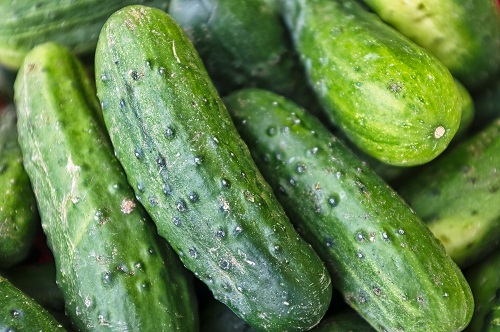Cucumber Farming

Type: Agriculture.
Key Products for Sale:
- Fresh Cucumbers: Selling fresh cucumbers to local markets, supermarkets, and restaurants.
- Pickling Cucumbers: Supplying cucumbers to pickling companies for processing into pickles.
- Value-added Products: Produce cucumber-based products such as cucumber juice, salads, and skincare products for niche markets.
Technology Considerations:
Greenhouse Technology: Utilizing greenhouse structures to control environmental factors such as temperature, humidity, and light intensity for year-round cucumber production.
Drip Irrigation Systems: Installing drip irrigation systems to deliver water and nutrients directly to the roots, improving water efficiency and crop yield.
Monitoring Apps: Using mobile apps for crop monitoring, pest management, and irrigation scheduling to optimize farm productivity.
Market for the Products:
Local Consumers: Selling fresh cucumbers directly to consumers through farmers’ markets or roadside stands.
Wholesale Buyers: Supplying cucumbers to wholesalers, retailers, and food distributors for wider market reach.
Food Processing Companies: Partnering with food processing companies to supply cucumbers for pickling and other value-added products.
Export Markets: Exploring export opportunities for high-quality cucumbers to international markets with high demand for fresh produce.
Key Inputs into the Business:
- Cucumber Seeds: Purchasing high-quality cucumber seeds from reputable suppliers.
- Fertilizers and Soil Amendments: Investing in fertilizers and soil amendments to maintain soil fertility and enhance crop growth.
- Irrigation Equipment: Acquiring drip irrigation systems or other irrigation equipment for efficient water management.
- Farm Machinery: Investing in basic farm machinery such as tractors, tillers, and sprayers for land preparation and crop maintenance.
- Labor: Hiring skilled labor for planting, harvesting, and farm maintenance activities.
Product Preparation Process:
Land Preparation: Clearing the land, plowing, and tilling to create suitable beds for cucumber cultivation.
Seed Sowing: Planting cucumber seeds in rows or raised beds at the appropriate spacing and depth.
Crop Maintenance: Providing regular watering, fertilization, and pest control to ensure healthy crop growth.
Harvesting: Harvesting cucumbers at the right stage of maturity based on size, color, and texture.
Packaging and Distribution: Packaging cucumbers in crates or boxes and distributing them to buyers or markets.
Quality Considerations:
Crop Management: Implementing good agricultural practices to minimize pest and disease pressure and ensure high-quality yields.
Harvesting Practices: Harvesting cucumbers at the optimal stage of ripeness to maintain flavor, texture, and nutritional value.
Post-Harvest Handling: Handling and packaging cucumbers carefully to prevent bruising and extend shelf life.
Food Safety Standards: Adhering to food safety regulations and standards to ensure that cucumbers are safe for consumption.
Cost of Investment:
Land Acquisition or Lease: Variable cost depending on the location and size of the farm.
Greenhouse Construction: KES 200,000 – KES 500,000 (for greenhouse farming).
Irrigation Systems: KES 50,000 – KES 150,000 (drip irrigation systems).
Seeds and Seedlings: KES 20,000 – KES 50,000 (for initial planting).
Fertilizers and Soil Amendments: KES 30,000 – KES 100,000 (per growing season).
Farm Machinery: KES 100,000 – KES 300,000 (for basic farm equipment).
Labor Costs: Variable costs depending on farm size and wage rates.
Required Operational Infrastructure:
Greenhouse Structures (if applicable): Providing controlled environments for year-round production.
Irrigation Systems: Ensuring efficient water delivery to crops.
Storage Facilities: Storing harvested cucumbers before distribution.
Packaging Materials: Packaging cucumbers for sale in markets or to buyers.
Transportation: Transporting cucumbers from the farm to markets or buyers.
Most Suitable or Viable Location of the Business:
Warm Climate Regions: Areas with warm temperatures and sufficient sunlight for cucumber cultivation.
Proximity to Markets: Locating the farm close to local markets, wholesalers, or food processing companies for easy distribution.
Access to Water: Availability of water sources for irrigation to support cucumber growth.
Potential Sources of Investment Capital:
Personal Savings: Investing personal funds into the cucumber farming business.
Agricultural Loans: Obtaining loans from financial institutions or agricultural development funds.
Government Grants: Exploring grants or subsidies available for agricultural startups or rural development initiatives.
Partnerships: Forming partnerships with investors or agricultural organizations for financing or resource support.
Requirements for Effective Management:
Farm Management Expertise: Hiring experienced farm managers or agronomists to oversee operations.
Skilled Labor: Employing skilled labor for various farm activities such as planting, irrigation, and harvesting.
Financial Management: Implementing sound financial practices for budgeting, cost control, and financial reporting.
Marketing Strategies: Developing marketing strategies to promote cucumber products and attract buyers.
Role of Mobile Phone and ICT in the Business:
Farm Management Apps: Using mobile apps for crop monitoring, irrigation scheduling, and pest management.
Online Marketing: Leveraging social media platforms and websites for marketing cucumber products to potential buyers.
Communication: Using mobile phones and email for communication with buyers, suppliers, and other stakeholders.
Statutory Regulations and Licenses:
Business Registration: Registering the cucumber farming business with the relevant authorities.
Land Use Permits: Obtaining permits for land use and agricultural activities.
Food Safety Standards: Complying with food safety regulations and standards for cucumber production and distribution.
Pricing:
Competitive Pricing: Setting prices for cucumbers competitively based on market demand, quality, and production costs.
Wholesale and Retail Pricing: Offering different pricing structures for wholesale buyers and retail markets.
Profitability:
Profit Potential: Cucumber farming can be highly profitable with the right management and market access.
Estimated Profits: Annual profits can range from KES 500,000 to KES 2,000,000 or more, depending on factors such as farm size, productivity, and market demand.
Next Steps to Take:
Land Acquisition or Lease: Secure land for cucumber farming.
Infrastructure Setup: Invest in greenhouse construction, irrigation systems, and other necessary infrastructure.
Crop Planning: Plan crop schedules and planting calendars for optimal production.
Marketing and Sales: Develop marketing strategies and establish relationships with buyers and markets.
Operational Management: Hire skilled labor and implement efficient farm.

